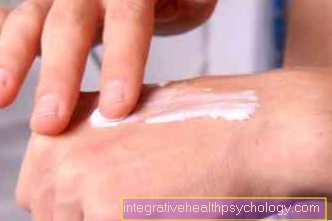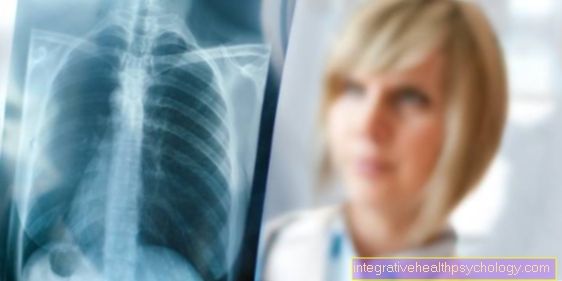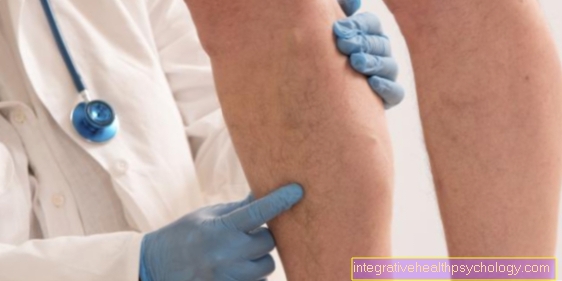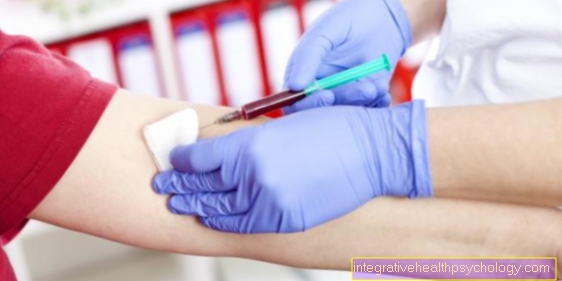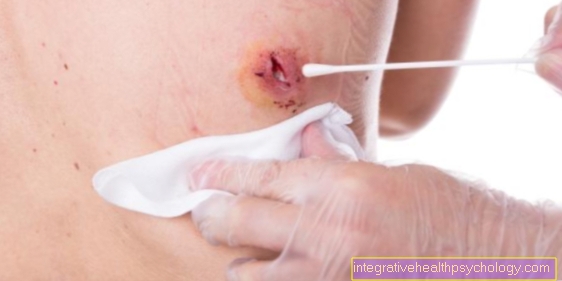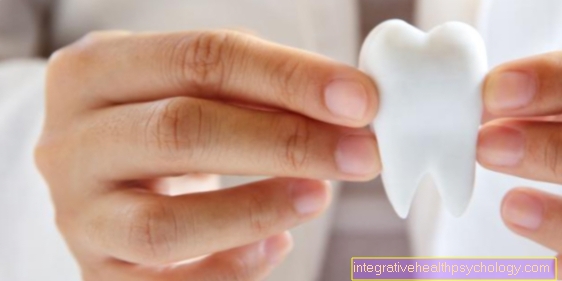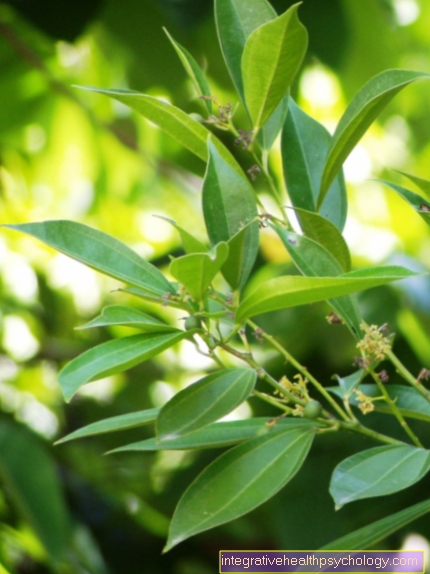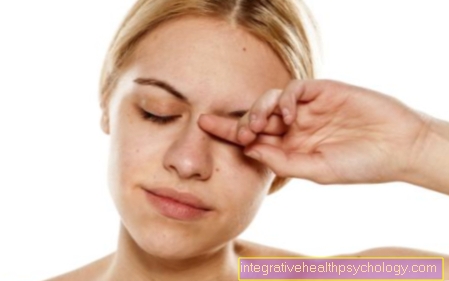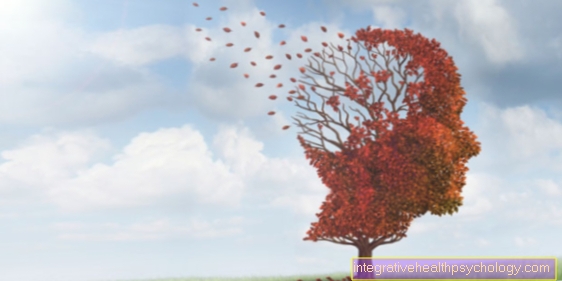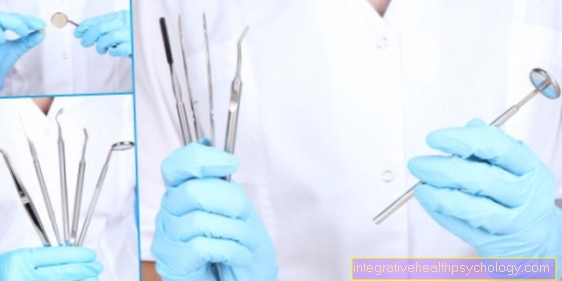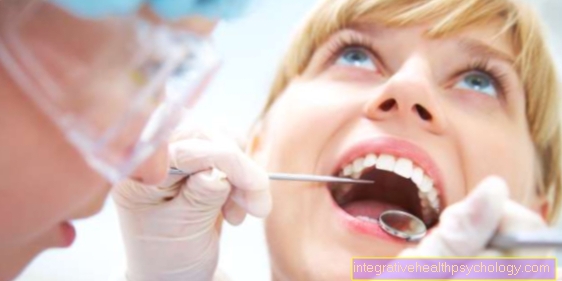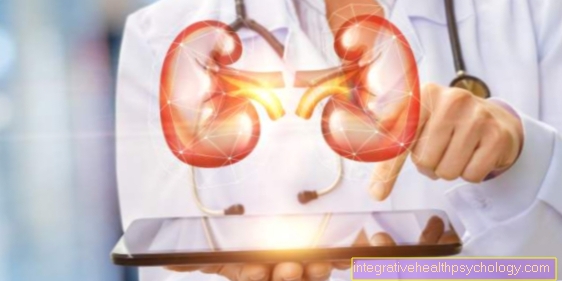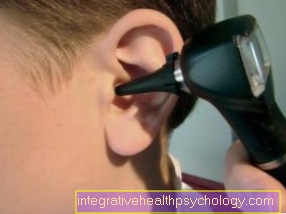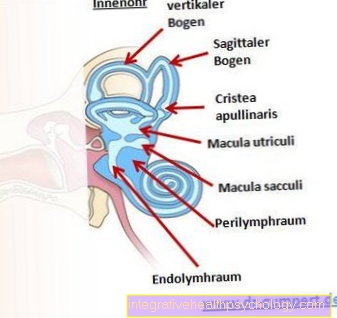Mosquito bite on the face
introduction
Everyone has probably already experienced a mosquito bite on their own body: the itching and redness usually last a few days after the actual bite before they subside. Mosquito bites can also occur on the face, i.e. in the area from the chin up to the hairline. Depending on where exactly the mosquito bite is located on the face, it can then appear more painful or larger than a mosquito bite elsewhere on the body. However, it does not differ significantly from mosquito bites that are not on the face. Therefore, treating the sting to relieve itching and swelling does not differ much from treating the rest of the body.

Concomitant symptoms
In a mosquito bite - as with most insect bites - the mosquito penetrates the skin at one point and causes what is known as a micro-injury. When the blood is sucked out by the mosquito, certain proteins and peptides, i.e. protein molecules, are then put into the puncture site. These serve to prevent the blood from clotting, but later cause typical symptoms such as swelling, reddening and itching to appear. The cause of this are the inflammation-promoting molecules that are released in the body in response to these proteins.
You may also be interested in this topic:
- Mosquito repellent
swelling
Swelling of the connective tissue is typical for allergic or inflammatory reactions. Both of these reactions lead to increased permeability of the blood vessel walls so that the cells of the immune system can get to the site of the potential infection and fend off the potentially dangerous pathogens or substances that have entered. Smaller molecules, such as the liquid components of the blood, naturally also pass through these permeable vessel walls. As a result, the tissue swells due to the fluid retention and wheals can form on the skin.
You might also be interested in this topic: Lymph node swelling after an insect bite
itching
Itching (medical pruritus) is a typical symptom of an allergic reaction, but it can also occur with many other complaints and diseases. How exactly itching occurs is not fully understood. A common theory is that itching is mediated by certain types of pain receptors, but their stimuli are not perceived as pain. It is also assumed that these nerve endings first have to be activated by certain substances.
It is known, however, that these nerve endings can be modulated by other stimuli such as heat or cold and the itching can thus be alleviated. Therefore, thermal (i.e. temperature-related) therapeutics such as cold and warming pillows or capsaicin ointment are a possibility for the acute treatment of itching.
Also read:
- Itchy mosquito bites - what to do?
infection
If the skin of the face at the point of the bite is scratched too much as a result of the itching, this represents a portal for pathogens to enter. Depending on the depth of the scratch, the risk of an infection resulting therefrom can be serious.
Preventive care should therefore be taken to ensure that the itching remains controllable and that any damaged skin is kept as clean as possible. Make-up or creams, for example, should be kept away from the scratched areas. Infections with pathogens that have been transmitted through the insect can also occur. Such diseases include malaria, dengue and yellow fever. All of these infectious diseases are not native to Europe and should be prevented with appropriate prophylaxis before traveling abroad to the corresponding areas.
Read more about this:
- Inflammation after a mosquito bite
This shows that the mosquito bite is dangerous
Although most mosquito bites are harmless and only cause uncomfortable itching, some mosquito bites can cause serious immunological reactions that should be investigated by a doctor.
This includes enormous swellings or pain, which are a hindrance to everyday activities. A doctor should also be consulted if feverish temperatures develop. In rare, severe cases, there may be a strong allergic reaction to a mosquito bite. Possible symptoms and signs are shortness of breath, severe itching or pain, rapid pulse, weak blood pressure, dizziness or loss of consciousness. A strong anaphylactic reaction requires emergency medical treatment!
This is how you can recognize an allergy to the mosquito bite
It is not easy to distinguish an allergic reaction to a mosquito bite from the normal reaction of the body: From a biochemical point of view, it is a similar mechanism with the same messenger substances.
In the case of an allergic reaction, however, there is generally a stronger reaction: larger wheals, more pronounced signs of inflammation such as redness, swelling and overheating, and itching that is sometimes painful. A mosquito bite can then appear like a horsefly or bee sting. The recommended therapy here - as with a normal reaction to a mosquito bite - is an anti-allergic ointment, preferably with a low dose of cortisone or hydrocortisol.
Mosquito bite on the eye
The skin area on and around the eye is particularly delicate and sensitive. A mosquito bite at this point is therefore usually more uncomfortable in many ways than elsewhere on the face: The bite can be more tense and painful, and the itching leads to injuries more quickly due to the thin skin, which pose a potential risk of infection.
Special care is therefore required here in order to calm the itching and at the same time not to irritate the eye and its protective apparatus. It is therefore not advisable to use sharp substances such as peppermint oil, which are cooling but can also irritate the conjunctiva of the eye. It is therefore better to apply a local antihistamine in the form of an ointment. Cortisone can also be used on the eye. Although a mosquito bite on the eye often appears uncomfortable and serious due to the swelling and reddening, it does not in itself pose a risk of infection. This actually only arises from scratching and the resulting skin damage, which is why the itching should be dampened here as well as possible.
Further information on this:
- Mosquito bite on the eye
therapy
Normally, mosquito bites with all their symptoms on the face subside after a few days at the latest.
If you want to alleviate the symptoms during this time, you can use a variety of home remedies as well as ointments and creams that contain a locally effective antihistamine or very weakly dosed cortisone. Antihistamines work on a biochemical level by inhibiting the release of allergic molecules. Cortisone shuts down the activity of the immune cells that trigger inflammatory symptoms such as redness, swelling and possible pain.
As home remedies, for example, cooling compresses or plant-based substances such as peppermint or tea tree oil can be applied to the puncture site to relieve itching and overheating. However, tea tree oil should never be used on damaged skin, as this will cause even more irritation. The best therapy is to be seen - as already indicated above - because normally a mosquito bite will subside by itself after a while.
Also read:
- Home remedies for mosquito bites
causes
The face is prone to mosquito bites insofar as it is usually not covered and is therefore easily accessible for mosquitoes. The mosquito then looks for a suitable place on the skin to be able to take blood from the superficial capillaries (the finest blood vessels). On the one hand, it has corresponding body parts as tools to be able to penetrate through the upper layers of the skin. On the other hand, when it is pricked, it injects certain molecules that are actually supposed to reduce blood clotting at the puncture site in order to make the blood sucking effortless. These molecules are later the main reason for the typical itching, reddening, swelling or even allergic symptoms.
Duration
Usually, a mosquito bite on the face should go away in two to three days, regardless of treatment. This can be recognized by the decrease in signs of inflammation such as redness, overheating and swelling. The itching should also subside by this time. If the area of the mosquito bite on the face has not been stressed too much by scratching and is not sore, no further difficulties should be expected after the bite has healed.
diagnosis
A diagnosis of a mosquito bite on the face is usually made by the appearance of the bite, location, and accompanying symptoms. Further diagnosis is usually not necessary.
Every now and then it can be difficult to differentiate between mosquito bites and blemishes or pimples. If in doubt, a therapy attempt can be started with a cream or ointment that helps against skin impurities, such as salicylic acid. If it is a mosquito bite, it can be irritated by it, but this should not significantly delay the healing process.
You might also be interested in this topic:
- Insect bite

